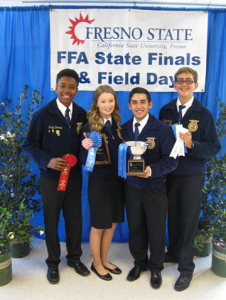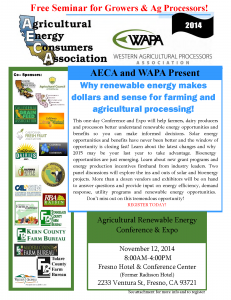The California Cotton Ginners and Growers Associations (CCGGA) and the Western Agricultural Processors Association (WAPA) submitted comments calling into question the proposed new requirements by CalOSHA. The new requirements would require lighting to be provided such that light can be measured at 10 foot-candle light power within a 25 foot radius when working around agricultural equipment. In attempting to determine the impact of these proposed rules, CCGGA and WAPA took measurements of an almond loading operation, cotton module unloading operation and a cotton bale loading operation, with all of these activities occurring at night. These measurements clearly demonstrated the inability to comply with the law as proposed, and in the one instance where additional had been provided to help rectify the situation, an air pollution control district violation was also created! As a result, CCGGA and WAPA have serious concerns with the premise for the proposed revisions, serious concerns with the industry’s ability to meet the proposed requirements for levels of light intensity, and issues with whether or not the standard is necessary based on a couple of the measurements we conducted. CCGGA and WAPA submitted the comments and the measurements in response to CalOSHA’s request for data supporting the industry’s claims that the proposed regulations are not necessary and impractical to meet.
NEWS & ISSUES
STAX/Farm Bill Webinars
As follow-up to the STAX/Farm Bill Workshops, the National Cotton Council is hosting a series of regional information webinars. Each session will include regional examples of insurance rates, county yields and information regarding farm programs.
Anyone who was unable to attend the meetings or who wishes additional information is welcome to participate in one the webinar sessions. To participate, call the conference number provided and then login to the webinar site. If you have any questions, contact the National Cotton Council, 901-274-9030.
Wednesday, December 17, 2014
Southeast Region:
9:00-11:00 am Central
10:00 am – 12:00 noon Eastern
MidSouth Region:
2:00 – 4:00 pm Central
Thursday, December 18, 2014
Southwestern Region:
9:00 – 11:00 am Central
Western Region:
11:00 am – 1:00 pm Pacific
12:00 noon-2:00 pm Mountain
Conference Number:
800-377-8846; Participant Code: 55634947#
Webinar login: https://cotton.adobeconnect.com/stax/
Webinar Instructions: Once at the web address, the default option is to enter as a Guest. Type your name into the box and Select the button “Enter Room”.
CCGGA and WAPA Continue to Oppose Changes to Heat Illness Standard
The California Cotton Ginners and Growers Associations (CCGGA) and the Western Agricultural Processors Association (WAPA) partnered with several other agricultural groups to submit comments in opposition to the proposed amendments to CalOSHA’s latest proposed revisions to the Heat Illness Standard. While the agency has removed the onerous and impractical distance requirements for shade and water, serious issues remain. The concerns focused on a failure to demonstrate necessity, as CalOSHA has not provided a shred of evidence that these changes will provide any additional protection over the existing standard. The group also expressed concerns with the additional rest period requirements that would only apply to agriculture! And while the distance requirement for shade at 700 feet was removed, it still requires shade to cover all employees at any point in time. This is not only impractical it is most likely impossible in an ag setting. These proposed changes were under a 15 day comment period. CalOSHA remains under serious pressure to pass these changes due to a lawsuit by the UFW. But the Associations remain resolute in opposition to the proposed changes and will remain so until such time as evidence is provided that demonstrates sufficient evidence to warrant revisions to the existing standard.
Port Issues Continue to Slow Down Business
It has been, nearly, three weeks since the issues at the port began, and the situation has not experienced any improvement. Long lines at the receiving terminal, the constant changing of containers, and the uncertainty of vessel departure times have led to higher costs on containers, storage fees as well as transportation.
With the processing season in full swing, more goods including cotton and tree nuts are expected to leave the ports for destinations across the seas. The effects of the delays at the ports have caused uncertainty among producers as to when their products will be delivered. The California Cotton Ginners and Growers Association (CCGGA) and the Western Agricultural Processors Association have been collecting information from many of our members regarding their experiences with the ports up to this point. Some of the repetitive reports that CCGGA and WAPA are receiving regards the long lines that transportation trucks have to wait in. One almond processor explained that “…the truckers are having to wait in lines for hours and sometimes they will wait in line for 4 to 6 hours and then get turned away because they decided to close.” This, in turn, is driving the price of transportation higher, as drivers are having to spend all day waiting in line to deliver one container. Container prices are also climbing because shipments are often being received, only to be transferred to a storage yard.
Not only are producers paying more to have their goods stored, but the delays at the ports also have the potential to cost the industry future business. “We have bookings that have rolled or been delayed by weeks. This creates a huge problem, especially when the sales are guaranteed delivery by a certain date,” wrote one almond shipper. Demand for tree nuts overseas is at its peak, and buyers are willing to find other producers or methods to meet their demands. One walnut processor was forced to pay twice as much in transportation fees to have his containers picked up from a storage yard at the port, and trucked across the country to the port in Montreal.
These issues must be resolved quickly in order to keep the industry functioning properly. CCGGA and WAPA have participated in conference calls with the California Department of Food and Agriculture, informing Secretary Karen Ross of the effects our industry is experiencing. To ensure that your voices are heard, WAPA has been sending updated reports to the Governor’s office, as well as Senator Feinstein’s office to collectively find a solution. If you have experienced the long lines at terminals, had your goods transferred to a storage yard when it should have been on an outgoing vessel, or have had to find other means of shipment to ensure your deadlines are met, we want to hear from you. Please send your information to Chris McGlothlin (chris@agprocessors.org).
EPA Releases Proposal to Update Ozone Standard
Today, the U.S. Environmental Protection Agency (EPA) proposed to strengthen the National Ambient Air Quality Standards (NAAQS) for ground-level ozone, based on what EPA claims is extensive scientific evidence about ozone’s effects on public health and welfare. With this announcement, business just got a whole lot tougher, if not impossible for California. EPA is proposing to update both the primary ozone standard, to protect public health, and the secondary standard, to protect the public welfare. Both standards would be 8-hour standards set within a range of 65 to 70 parts per billion (ppb). EPA is also seeking comment on potentially setting the levels for the health standard as low as 60 ppb! To put this in perspective, in the 1990’s the Central California Ozone Studies measured background ozone levels on the Farallon Islands off the California Coast of 60 ppb! The San Joaquin Valley Air Pollution Control District has made the comment that it would take the elimination of every car, truck, tractor and cow and it would still be unable to achieve this standard. Ozone forms in the atmosphere when emissions of nitrogen oxides and volatile organic compounds “cook” in the sun. Emissions from sources such as cars, trucks, buses, industries, power plants, and products such as solvents and paints are among the major man-made sources of ozone-forming emissions. As required by the Clean Air Act, EPA would make attainment/nonattainment designations for any revised standards by October 2017; those designations likely would be based on 2014-2016 air quality data. A number of California counties likely would have attainment dates ranging from 2032 to late 2037. EPA analyzed the benefits and costs for California separately, because a number of areas in California would have longer to meet the proposed standards. Estimated costs in California post-2025 are $800 million for a standard of 70 ppb and $1.6 billion for a standard of 65 ppb.
CCGGA & WAPA Reaction to the Withdrawal of Negotiations on Critical Water Legislation
For Immediate Release:
CONTACT:
Roger A. Isom, President/CEO Phone: (559)252-0684
California Cotton Ginners and Growers Associations Fax: (559)252-0551
Western Agricultural Processors Association email: roger@ccgga.org
CCGGA/WAPA President/CEO Roger Isom reacted to the withdrawal of negotiations on federal drought legislation by stating “It is unconscionable to walk away from talks at this point in time. In a year where hundreds of thousands of acres of productive farmland received zero surface water, this delay is unacceptable. Thousands of acres lay fallow and productive orchards were ripped out – this is unacceptable. The jobs that are associated with this acreage go far beyond the individual farmer and his family. It affects farm workers and their families, the fuel delivery personnel and their families, the custom harvesters and their families, the bankers and their families, the insurance companies and their families, the equipment dealers and their families. The list goes on and one thing remains the same. The lack of water is devastating. There are cities in the San Joaquin Valley that are without water for even the basic necessities. This is not a time when politics should come before the needs of the people.
While we applaud the bipartisanship that went into the serious negotiations that were undertaken, the fact remains that there will be no legislation this year. Despite assurances that this will be taken up early in the next session it is simply too late. Another planting season will have gone by. Without a miracle winter, more acreage will be removed. Consequently, more farmworkers will be laid off or simply not hired. There will be even less work for the fuel suppliers, harvesters, banks, chemical supply companies, equipment dealers, and others that rely upon a viable agricultural industry.
We don’t know what happened or why the negotiations were discontinued, but it doesn’t matter. Simply put, something has to be done to provide more water at these critical times. Farmers have done their part by investing billions converting irrigation systems to automated, high-efficiency, low water use systems, such as buried drip on cotton. It’s time for Congress to do theirs.“
The California Cotton Ginners and Growers Associations are trade organizations representing cotton growers and cotton gins throughout California. The Western Agricultural Processors Association is a trade organization representing tree nut hullers and processors of almonds, pecans, pistachios and walnuts. All three organizations are operated and managed in the same offices in Fresno, California.
Fresno State’s Plant Science Club brings home the President’s Trophy
Competing against 14 major U.S. universities with agriculture programs, Fresno State’s Plant Science Club brought home the President’s Trophy for the national Students of Agronomy, Soils and Environmental Sciences (SASES) club speech contest. The completion was held during the Tri-Societies (American Society of Agronomy, Crop Science and Soil Science) recent national conference held in Long Beach, CA. The contest challenged student clubs from agriculture universities to showcase their activities in community service, educational outreach, and professionalism in plant/crop and soil sciences. Armando Guzman, also one of two Fresno State Plant Science students selected as a Golden Opportunity Scholar, presented the slide show on the Plant Science Club’s activities. This is the second win in the three years Fresno State’s Plant Science Club has participated in this event. A delegation of 12 Plant Science Club members was able to attend the conference from Associated Student Incorporated funds and cheered for the clubs accomplishment. Additional students competed in the College Quiz Bowl, Crops Judging Contest and served as delegates for the national SASES meetings. Mala To, Plant Science Club president, said “I am very proud of our accomplishments and involvement in this year’s club activities. Next year, our club members will be going to Minneapolis, MN to compete and bring home the Trophy again.”
2014 FFA Cotton Judging Event
The team from Atwater FFA took the first place honors for the First High Team A at the 57th Annual State FFA Cotton Judging Competition held at Fresno State. Lemoore FFA took first place in the B competition. Team members judged cotton lint, seed, bolls, plants, and took a general knowledge test of the California cotton industry. Taking home individual honors was Atwater’s Amanda Skidmore in the A competition and Firebaugh’s Austin La Salle in the B competition. Bruce Roberts from Fresno State coordinates and hosts the competition, which was held on Saturday, November 8th this year. The California Cotton Ginners and Growers Associations, the California Cotton Alliance, and Supima are sponsors of the annual event held on the campus of Fresno State. Congratulations to all who competed!
Reminder — California STAX/Farm Bill Workshop
As a reminder, NCC will hold a STAX/Farm Bill Workshop on Monday, November 10, 9:00 a.m. at Harris Ranch in the Garden Ballroom. The address is 24505 West Dorris Drive, Coalinga.
This meeting is co-hosted by California Cotton Ginners, California Cotton Growers and the San Joaquin Valley Quality Cotton Growers Association.
We hope your schedule will permit you to attend this important meeting. Please contact Mike Brueggemann at (559) 696-6823 or mbrueggemann@cotton.org with any questions.
Thanks for your continued support of the National Cotton Council.


